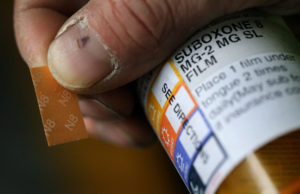 Months in prison didn’t rid Daryl of his addiction to opioids. “Before I left the parking lot of the prison, I was shooting up, getting high,” he says.
Months in prison didn’t rid Daryl of his addiction to opioids. “Before I left the parking lot of the prison, I was shooting up, getting high,” he says.
Daryl has used heroin and prescription painkillers for more than a decade. Almost four years ago he became one of more than 200 people who tested positive for HIV in a historic outbreak in Scott County, Ind. After that diagnosis, he says, he went on a bender.
But about a year ago, Daryl had an experience that made him realize he might be able to stay away from heroin and opioids. For several days, he says, he couldn’t find drugs. He spent that time in withdrawal.
“It hurts all over. You puke, you get diarrhea,” Daryl says.
His friend offered him part of a strip of Suboxone, a brand-name version of the addiction medication buprenorphine that is combined with naloxone. Buprenorphine is a long-acting opioid that is generally used to treat opioid addiction. It reduces cravings for the stronger opioids he had been taking, prevents physical withdrawal from those drugs and comes with a significantly lower risk of fatal overdose.
Daryl injected the buprenorphine, and his opioid withdrawal symptoms disappeared. (Daryl is his middle name, which NPR is using to protect his identity because it is illegal to use buprenorphine without a prescription.)
“At first it felt like I was high,” Daryl says. “But I think that’s what normal feels like now. I have not been normal in a long time.”
Weeks later, the grind of chasing heroin had worn on him. Buprenorphine controlled his withdrawal symptoms longer, and Daryl decided to use it to stay away from other drugs.
